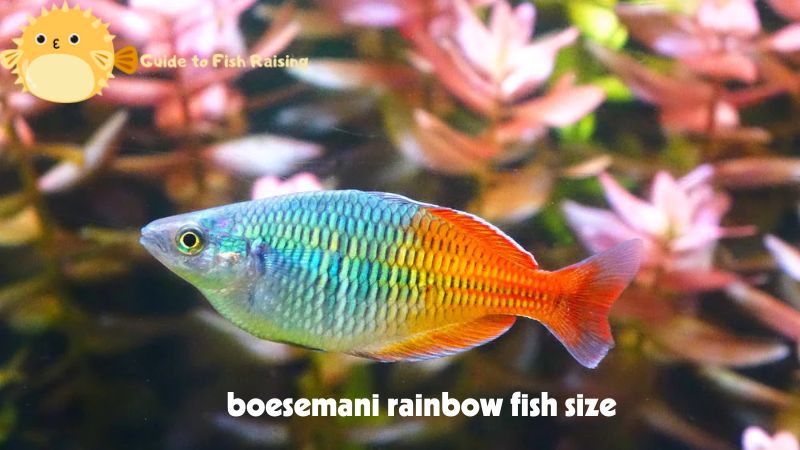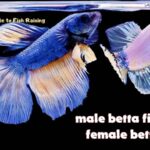One of the most prominent and recognizable rainbow fish is the boesemani rainbow fish size. This schooling fish is prized for its unique bi-colored body and is the perfect addition to a mid-sized community aquarium. fishtankenthusiast.com helps you learn boesemani rainbow fish size, what is needed to keep this beautiful fish happy, healthy and showing off its most beautiful colors possible.
What is Boesemani rainbow fish? boesemani rainbow fish size
Melanotaenia boesemani has classic rainbow fish characteristics with a pointed snout, deep body and large, distinct scales. Males measure up to 4 inches (10 cm) and have an iridescent blue front half and an orange back half. Females are less colorful, have slimmer bodies, and tend to be about 3 inches (8 cm) long. They are currently endangered in the wild, so Boeseman rainbow fish sold in the aquarium hobby are all captive bred. However, the rainbow fish you see at the pet store are usually 2-inch (5 cm) long juveniles that look pale and bear little resemblance to adults. It can take up to a year of good care and high-quality food for them to color, but the results are worth the wait.
How long is the Boesemani rainbow fish’s lifespan? Depending on the water temperature you keep them in, they can live an average of about 5–8 years, although some aquarium keepers report they can live up to 13–15 years.
How to set up an aquarium for Boesemani rainbow fish
boesemani is adapted to alkalinity and general hardness. They are susceptible to changes in pH, dissolved oxygen, temperature and water quality. They need pure water with very little nitrogenous waste (ammonia, nitrite, nitrate).
PH
The pH must be stable and maintained at a level of 6.5 to 7.8. In my experience with M. boesemani in high-tech aquariums, pH swings from 6.4 to 7.0 over a 24-hour period when CO2 levels change do not adversely affect their health.
Dissolved oxygen
Rainbowfish can be sensitive to dissolved oxygen levels. An aquarium with a vigorously agitated surface and a moderate flow from the filter will provide enough dissolved oxygen if the tank is not overcrowded with fish. Pale gill filaments, rapid breathing, and panting at the surface can all be indicators that the aquarium’s oxygen content is low. You can fix this by increasing surface agitation using an air bubble setting, increasing the flow from the filter, or installing a circulation pump inside the tank.
Alkalinity and general hardness
Alkalinity should be maintained consistently between 2.8 and 11 carbonate hardness (dKH), with 4-8 dKH being the optimal range. General hardness should be maintained consistently between 2.8 and 14 general hardness (dGH), with 4-10 dGH being the optimal range. Rainbowfish may tolerate conditions at the lowest, maximum, or even higher in this range because they are insensitive to alkalinity and general hardness. However, general alkalinity and hardness above 11 and 14 respectively can affect other aspects of your aquarium’s chemistry, like pH and CO2 levels.

Temperature
boesemani, like many other fish species, is poy-key-low-therm-ic. This means that their body temperature fluctuates around the temperature of their environment. Raising the aquarium temperature to over 80 degrees will result in a higher metabolism, faster growth rate, shorter lifespan and the need to absorb more nutrients. It’s best to keep them between 78 and 80 degrees Fahrenheit.
Lighting
Rainbow fish are known to run around the aquarium frantically in response to sudden and intense increases in light. This can lead to injury and the fish jumping out of the aquarium. Using a dimmer or turning on the aquarium light after the room is lit will help minimize this reaction.
What do Boesemani rainbow fish eat?
boesemani are known for their vibrant colors. These hues are achieved and maintained by them eating a proper diet. Rainbow fish come from a variety of habitats and their diet reflects that. As opportunistic feeders, they will consume nearly anything that is offered to them. The natural diet of most rainbowfish, including M. boesemani, consists of live foods such as aquatic vegetation, terrestrial insects, small aquatic crustaceans, insect larvae , worms, phytoplankton, zooplankton, organic detritus and sometimes smaller fish. According to Tappin (2010), aquatic insects (35%) and crustaceans (14.4%) make up the majority of their natural diet.
The brilliant colors, development, and fertility of these fish can be preserved with the right food in the aquarium.The diet should include protein-rich foods with a variety of nutrients, minerals and vitamins. A high-quality pellet or flake feed can provide additives such as vitamins and minerals. A suitable pellet or flake food will also include some plant ingredients, such as spirulina or chlorella. You should add frozen foods such as bloodworms, rotifers, copepods, crustaceans or Mysis shrimp.
I suggest introducing a tiny piece of cucumber or zucchini to the aquarium once or twice a week. Rainbow fish are known to readily eat these and they provide a range of nutrients that would otherwise be unavailable. Any species of shrimp, algae eaters and snails will love this addition.
You can also provide your aquarium with a separate fish vitamin formula that helps maintain their coloration, immune system, and reproductive health. Regardless, feeding your fish high-quality processed food with protein and plant matter, and frozen or live food daily will keep your rainbow fish fresh and healthy.
How to breed Boesemani Rainbow fish
Boesemanis is one of the easiest rainbow fish to spawn, but its small fry can be difficult to raise. Start by making sure you have both male and female fish, and prepare them for spawning by feeding them more. Set up a spawning tank with a slightly alkaline pH, warmer temperature, and a sponge filter that will not absorb all the fry. Place the adult fish in the prepared tank with a homemade spawning mop. Male fish will have a white stripe on their head and dance to attract female fish. Each day, they will lay a small batch of eggs and after 7–10 days, you can remove the parents or remove the eggs to prevent the adults from preying on the fry.
Three to five times a day, feed the fry with fried food, vinegar eel, protozoa and other small foods. Keep the water clean by changing it regularly to remove uneaten food. Finally, feed them baby brine shrimp, this will help them grow fast and healthy. Boesemani rainbow fish take longer to raise than many other fish, but they are fun to keep and will one day grow into beautiful adults.





